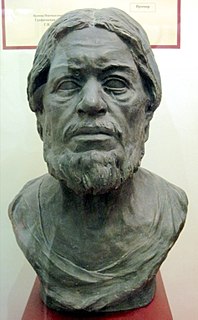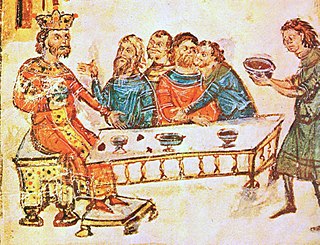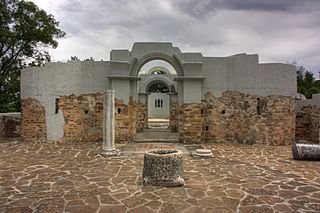
Samuel was the Tsar (Emperor) of the First Bulgarian Empire from 997 to 6 October 1014. From 977 to 997, he was a general under Roman I of Bulgaria, the second surviving son of Emperor Peter I of Bulgaria, and co-ruled with him, as Roman bestowed upon him the command of the army and the effective royal authority. As Samuel struggled to preserve his country's independence from the Byzantine Empire, his rule was characterized by constant warfare against the Byzantines and their equally ambitious ruler Basil II.

Dobruja or Dobrudja is a historical region in Eastern Europe that has been divided since the 19th century between the territories of Bulgaria and Romania. It is situated between the lower Danube River and the Black Sea, and includes the Danube Delta, Romanian coast, and the northernmost part of the Bulgarian coast. The territory of Dobruja is made up of Northern Dobruja, which is part of Romania, and Southern Dobruja, which belongs to Bulgaria.

The Battle of Kleidion took place on July 29, 1014 between the Byzantine Empire and the Bulgarian Empire. It was the culmination of the nearly half-century struggle between the Byzantine Emperor Basil II and the Bulgarian Emperor Samuil in the late 10th and early 11th centuries. The result was a decisive Byzantine victory.

The Second Bulgarian Empire was a medieval Bulgarian state that existed between 1185 and 1396. A successor to the First Bulgarian Empire, it reached the peak of its power under Tsars Kaloyan and Ivan Asen II before gradually being conquered by the Ottomans in the late 14th and early 15th centuries. It was succeeded by the Principality and later Kingdom of Bulgaria in 1878.

The Basarabi-Murfatlar Cave Complex is a medieval Christian monastery located near the town of Murfatlar, Constanța County, Northern Dobruja, Romania. The Complex is a relict from a widespread monastic phenomenon in a 10th century Bulgaria.

The Battle of the Gates of Trajan was a battle between Byzantine and Bulgarian forces in the year 986.
Dorothea of Bulgaria, also called Doroslava (Дорослава), was the first Queen of Bosnia. Daughter of the Bulgarian tsar Ivan Sratsimir, Dorothea was held hostage by King Louis I of Hungary, who married her off to Ban Tvrtko I of Bosnia in 1374. She became queen in 1377 and may have been the mother of King Tvrtko II.
Nestoritsa was a Bulgarian noble and general during the reign of Emperors Samuil (997-1014); Gavril Radomir (1014–1015) and Ivan Vladislav (1015–1018). He was one of Bulgaria's most skilful military commanders.
The battle of Thessalonica was fought between the Bulgarian and the Byzantine Empires in the summer of 1014 near the city of Thessalonica in contemporary northern Greece. The Bulgarian army under the command of Nestoritsa was defeated by the Byzantines led by the governor of Thessalonica Theophylactus Botaniates and it was unable to divert the main Byzantine forces who were attacking the Bulgarian ramparts between the Belasitsa and Ograzhden mountains.
The Battle of Strumica took place in August 1014, near Strumica, present-day Republic of Macedonia, between Bulgarian and Byzantine forces. Bulgarian troops under Emperor Samuil's son Gavril Radomir defeated the army of the governor of Thessaloniki, Theophylactus Botaniates, who perished in the battle. After his death the Byzantine Emperor Basil II was forced to pull back from Bulgaria and was unable to take advantage of his success in the recent Battle of Kleidion.
The battle of Bitola took place near the town of Bitola, in Bulgarian territory, between a Bulgarian army under the command of the voivoda Ivats and a Byzantine army led by the strategos George Gonitsiates. It was one of the last open battles between the First Bulgarian Empire and the Byzantine Empire. The Bulgarians were victorious and the Byzantine Emperor Basil II had to retreat from the Bulgarian capital Ohrid, whose outer walls were by that time already breached by the Byzantines. However, the Bulgarian victory only postponed the fall of Bulgaria to Byzantine rule in 1018.

The Battle of Philippopolis or Battle of Plovdiv took place on 30 June 1208 in the surroundings of Philippopolis between the armies of the Bulgarian Empire and the Latin Empire. The Crusaders were victorious.

The medieval Bulgarian army was the primary military body of the First and the Second Bulgarian Empires. During the first decades after the foundation of the country, the army consisted of a Bulgar cavalry and a Slavic infantry. The core of the Bulgarian army was the heavy cavalry, which consisted of 12,000–30,000 heavily armed riders. At its height in the 9th and 10th centuries, it was one of the most formidable military forces in Europe and was feared by its enemies. There are several documented cases of Byzantine commanders abandoning an invasion because of a reluctance to confront the Bulgarian army on its home territory.

The Round Church, also known as the Golden Church or the Church of St John, is a large partially preserved early medieval Eastern Orthodox church. It lies in Preslav, the former capital of the First Bulgarian Empire, today a town in northeastern Bulgaria. The church dates to the early 10th century, the time of Tsar Simeon I's rule, and was unearthed and first archaeologically examined in 1927–1928.
Prespa was a medieval town, situated in the homonymous area in south-western Macedonia. It was a residence and burial place of the Bulgarian emperor Samuel and according to some sources capital of the First Bulgarian Empire and seat of the Bulgarian Patriarchate in the last decades of the 10th century.
The Byzantine–Bulgarian war of 894–896, also called the Trade war, was fought between the Bulgarian Empire and the Byzantine Empire as a result of the decision of the Byzantine emperor Leo VI to move the Bulgarian market from Constantinople to Thessaloniki which would greatly increase the expenses of the Bulgarian merchants.
The Bulgarian–Serbian wars of 917–924 were a series of conflicts fought between the Bulgarian Empire and the Principality of Serbia as a part of the greater Byzantine–Bulgarian war of 913–927. After the Byzantine army was annihilated by the Bulgarians in the battle of Achelous, the Byzantine diplomacy incited the Principality of Serbia to attack Bulgaria from the west. The Bulgarians easily dealt with that threat and replaced the Serbian prince with a protégé of their own. In the following years the two empires competed for control over Serbia. In 924 the Serbs rose again, ambushed and defeated a small Bulgarian army. That turn of events provoked a major retaliatory campaign that ended with the annexation of Serbia in the end of the same year.
The Byzantine–Bulgarian war of 913–927 was fought between the Bulgarian Empire and the Byzantine Empire for more than a decade. Although the war was provoked by the Byzantine emperor Alexander's decision to discontinue paying an annual tribute to Bulgaria, the military and ideological initiative was held by Simeon I of Bulgaria, who demanded to be recognized as Tsar and made it clear that he aimed to conquer not only Constantinople but the rest of the Byzantine Empire, as well.
Joachim III was the Patriarch of the Bulgarian Orthodox Church between c. 1282 and 1300, when the Second Bulgarian Empire reached its lowest point of decline during the reign of the emperors George Terter I, Smilets and Chaka. He was executed for treason by emperor Theodore Svetoslav in 1300. The Church did not recognize his guilt and his name was included in the list of Bulgarian Patriarchs in the Book of Boril. His seat was Tarnovo, the capital of Bulgaria.

The Rebellion of Bardas Phokas the Younger was a major Byzantine civil war fought mostly in Asia Minor. During the second half of the tenth century the Byzantine Empire was characterized by emperors either devoted to or forced into long periods of campaigning mostly in the Middle East, Crete, Cyprus, Antioch; many other territories were also conquered during this period. The success Byzantium experienced during this period was largely thanks to the Phokas clan, an aristocratic family who consistently produced competent generals, and their relatives. Indeed, during the reigns of Nikephoros II Phokas and his nephew John I Tzimiskes, these aristocratic generals supplanted the legitimate heirs of the Macedonian dynasty, the adolescent brothers Basil II and Constantine VIII, as the true rulers of the empire. When Tzimiskes died in 976 Basil II ascended to power. Quickly, however, tensions began to flare up within the royal court itself as the purple-born emperor attempted to reign fully out of the influence of the established court eunuchs. The figureheads behind the simmering tensions in the capital would come to blows in a major rebellion lead by Bardas Phokas the Younger, the most powerful man left of the old Phokas regime.












